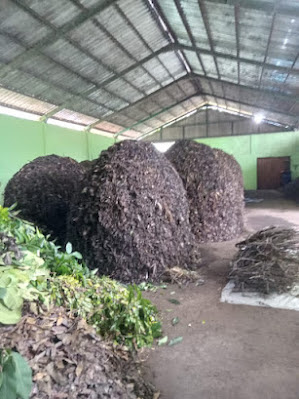
Photo taken from here
The MSW problem is a concern in a number of areas currently. This is because MSW, apart from being a serious environmental problem, also has an impact on social problems. The public is starting to become more aware of this MSW problem, especially for urban communities who no longer have land to pile up or burn their MSW and what's more, final disposal sites are no longer able to accommodate the MSW produced by these communities. Flooding, groundwater pollution, air pollution are some of these environmental problems which, if not addressed, will cause a number of serious environmental problems. Public awareness regarding waste should be getting better day by day, and various efforts should be made to overcome it.

One of the composting unit in Indonesia
Currently the central government and regional governments are working hard to overcome the waste problem namely this MSW. Despite hard efforts, generally only a small portion of the MSW can be handled and most of it is still accumulating and accumulating so that it continues to pile up. An example is the current MSW problem in Jakarta, the capital of Indonesia namely with an average daily waste volume of 7,500 tons/day, only around 1,000 tons per day can be processed. With the RDF production unit at Bantar Gebang TPST, with raw materials of 2,000 tons of waste per day originating from 1,000 tons of new MSW and 1,000 tons of old waste (landfill mining), approximately 700 tons/day of RDF is produced. So with only 1,000 tons/day of new waste that can be processed, that means only 13% of the total daily waste volume. Meanwhile, conditions in a number of regions in Indonesia are also almost the same.
Future MSW processing must be able to process the 100% of MSW or have zero waste. Apart from that, the MSW processing product must also have useful and economic value. One of them is large capacity RDF and compost production. Almost all organic waste can be composted, while non-organic waste, especially plastic, can be made into RDF. Other waste such as iron, glass, ceramics and metals are separated first so that it does not interfere with the RDF and compost production process. RDF is commonly used as an alternative fuel, especially in cement plants. However, with high chlorine content, the use of RDF in cement plants needs to be limited.
Sometimes the distance between RDF production and the cement plant makes transportation costs expensive and RDF products become uncompetitive. This means that RDF needs to be compressed into RDF pellets. By increasing the density of RDF into pellets, apart from saving transportation costs, it will also make handling, storage and use easier. Meanwhile, biochar can be added to compost to improve its quality. Biochar is added during the composting process and later there will be more nutrients contained in the compost. Biochar with its micro pores will be used as a place to store these nutrients. Apart from that, biochar is used as a carbon sink / carbon sequestration and can survive in the soil for hundreds or even thousands of years. This also has the potential to provide additional income from carbon credits. Biochar production by pyrolysis will also produce heat energy which can be used for drying waste in RDF production and pyrolysis of organic materials.



Tidak ada komentar:
Posting Komentar